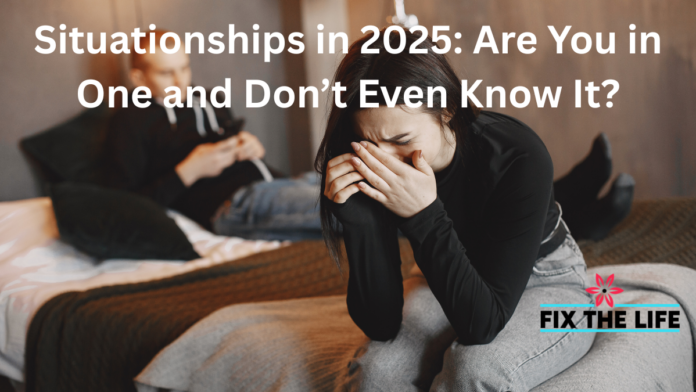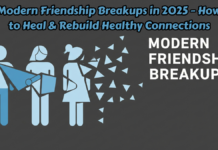Dating in 2025 has evolved, bringing new relationship dynamics and blurred boundaries. One of the most perplexing modern dating terms is situationship, a bond that exists somewhere between casual dating and a committed relationship—without clear labels. If you’ve been unsure where your relationship stands, you may unknowingly be in a situationship.
This article explores situationship meaning 2025, key casual relationship signs, and how to determine if your connection lacks clarity.
What Is a Situationship in 2025?
A situationship is an undefined romantic or emotional relationship that lacks commitment but still has elements of intimacy. Unlike a traditional relationship, there are no clear boundaries, exclusivity agreements, or long-term plans.
Key Characteristics of Situationships:
- Unclear relationship status
- No discussion of future plans
- Sporadic communication without emotional depth
- Physical intimacy exists but lacks emotional commitment
- One or both partners avoid serious conversations about “what this is”
In 2025, as digital dating grows and non-traditional connections become more common, situationships are more prevalent than ever.
Signs You Might Be in a Situationship
If you’re unsure whether your connection qualifies as a relationship or just a fleeting attachment, look out for these casual relationship signs:
1. There’s No Label
You might share emotions, spend time together, and even have a physical connection, but there’s no defined title—no commitment, no “official” status.
2. Inconsistent Communication
Your conversations range from deep and engaging to barely existent. One week, you’re texting daily, but the next, you’re ghosted without explanation.
3. No Future Talk
A relationship typically involves planning for the future—vacations, moving in together, or long-term goals. A situationship avoids these topics entirely.
4. You Only Meet When It’s Convenient
Your partner isn’t prioritizing quality time but instead meets you only when it suits their schedule. There’s no structure or routine, just spontaneous meet-ups.
5. Effort Feels One-Sided
Are you always initiating conversations, planning dates, or seeking emotional validation? Situationships tend to be imbalanced, where one person invests more effort.
6. Exclusivity Is Vague
If you haven’t discussed exclusivity but sense they might be seeing others, your relationship lacks boundaries.
7. Emotional Investment Is Low
Unlike serious relationships where emotional support is a key factor, a situationship often feels emotionally distant or unreliable.
Why Situationships Are More Common in 2025
The dating landscape has shifted significantly, and situationships are more frequent due to several cultural trends:
1. Digital Dating & Casual Connections
Apps like Tinder and Bumble have encouraged a culture of “keeping options open,” making non-committal relationships more common.
2. Fear of Commitment
More individuals prioritize career, independence, and personal growth over traditional relationships, delaying commitment.
3. Shift in Relationship Norms
Casual relationships are now socially acceptable, reducing the pressure to label or define romantic connections.
4. Emotional Burnout & Avoidance
Many fear vulnerability or emotional attachment, leading to less defined, commitment-free relationships.
How to Get Out of a Situationship
If you want clarity, consider taking proactive steps:
1. Communicate Honestly
Ask direct questions: “Where do we stand?” or “Are we moving toward commitment?”
2. Set Boundaries
Define expectations and avoid settling for a relationship that doesn’t fulfill your emotional needs.
3. Recognize Your Own Value
You deserve a stable, fulfilling relationship. If your partner isn’t providing emotional commitment, it might be time to move forward.
4. Walk Away If Necessary
If they can’t commit, respect your own well-being and remove yourself from a situation that doesn’t serve you.
Recommendation
Narcissistic vs. Toxic Partner – How to Spot the Difference
How to Set Healthy Boundaries Without Feeling Guilty
How to Identify Emotional Manipulation in Any Relationship
10 Healthy Relationship Habits Every Couple Should Practice
7 Signs You’re in a One-Sided Relationship
15 Relationship Goals for Couples in 2025: Build a Stronger Bond
FAQs: Common Questions About Situationships
Q1: What is the biggest difference between a situationship and a casual relationship?
A casual relationship is understood to be temporary and non-committal, while a situationship often has undefined boundaries, leaving people uncertain.
Q2: How can I tell if my partner wants something serious or if we’re stuck in a situationship?
Look for signs like consistent effort, future discussions, and emotional availability. If these are missing, you may be in a situationship.
Q3: Are situationships unhealthy?
Not always—some people prefer casual connections. However, if it leaves you confused or emotionally drained, it might be time to reconsider.
Q4: Can a situationship turn into a committed relationship?
Yes, if both individuals openly communicate and establish mutual commitment. However, in many cases, situationships remain stagnant.
Q5: What should I do if I realize I’m in a situationship?
Evaluate your feelings and decide if this arrangement fulfills you. If not, discuss clarity with your partner or consider moving on.
Final Thoughts
Situationships in 2025 are a reflection of shifting dating norms, where emotional ambiguity has become a familiar aspect of modern relationships. While some may find comfort in undefined connections, others may struggle with the lack of clarity. Ultimately, knowing your own worth and relationship goals will help you navigate these evolving dynamics. Whether you choose to embrace a situationship or seek commitment, the key is to prioritize what truly fulfills you.




